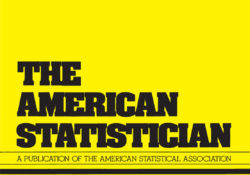tandfonline.com har udgivet en rapport under søgningen “Teacher Education Mathematics”: Abstract Abstract The “New Statistics” emphasizes effect sizes, confidence intervals, meta-analysis, and the use of Open Science practices. We present three specific ways in which a New Statistics approach can help improve scientific practice: by reducing overconfidence in small samples, by reducing confirmation bias, and by fostering more cautious judgments of consistency. We illustrate these points through consideration of the literature on oxytocin and human trust, a research area that typifies some of the endemic problems that arise with poor statistical practice. Link til kilde
Like this:
Like Loading...
tandfonline.com har udgivet en rapport under søgningen “Teacher Education Mathematics”: ABSTRACT ABSTRACT More than 50 years ago, John Tukey called for a reformation of academic statistics. In “The Future of Data Analysis,” he pointed to the existence of an as-yet unrecognized science, whose subject of interest was learning from data, or “data analysis.” Ten to 20 years ago, John Chambers, Jeff Wu, Bill Cleveland, and Leo Breiman independently once again urged academic statistics to expand its boundaries beyond the classical domain of theoretical statistics; Chambers called for more emphasis on data preparation and presentation rather than statistical modeling; and Breiman called for emphasis on prediction rather than inference. Cleveland and Wu even suggested the catchy name “data science” for this envisioned field. A recent and growing phenomenon has been the… Continue Reading →
Like this:
Like Loading...
tandfonline.com har udgivet en rapport under søgningen “Teacher Education Mathematics”: Abstract Formulae display:?Mathematical formulae have been encoded as MathML and are displayed in this HTML version using MathJax in order to improve their display. Uncheck the box to turn MathJax off. This feature requires Javascript. Click on a formula to zoom. Abstract The flipped classroom (FC) inverts the traditional classroom by having students participate in passive aspects of learning at home and active aspects of learning in class with the guide of an instructor. The introductory statistics course for nonmath majors may be especially suited to the FC model given its unique challenges as a required course for students with varying mathematical skills and background. For example, these students often have low interest and high statistics-related anxiety. Recent studies suggest… Continue Reading →
Like this:
Like Loading...


